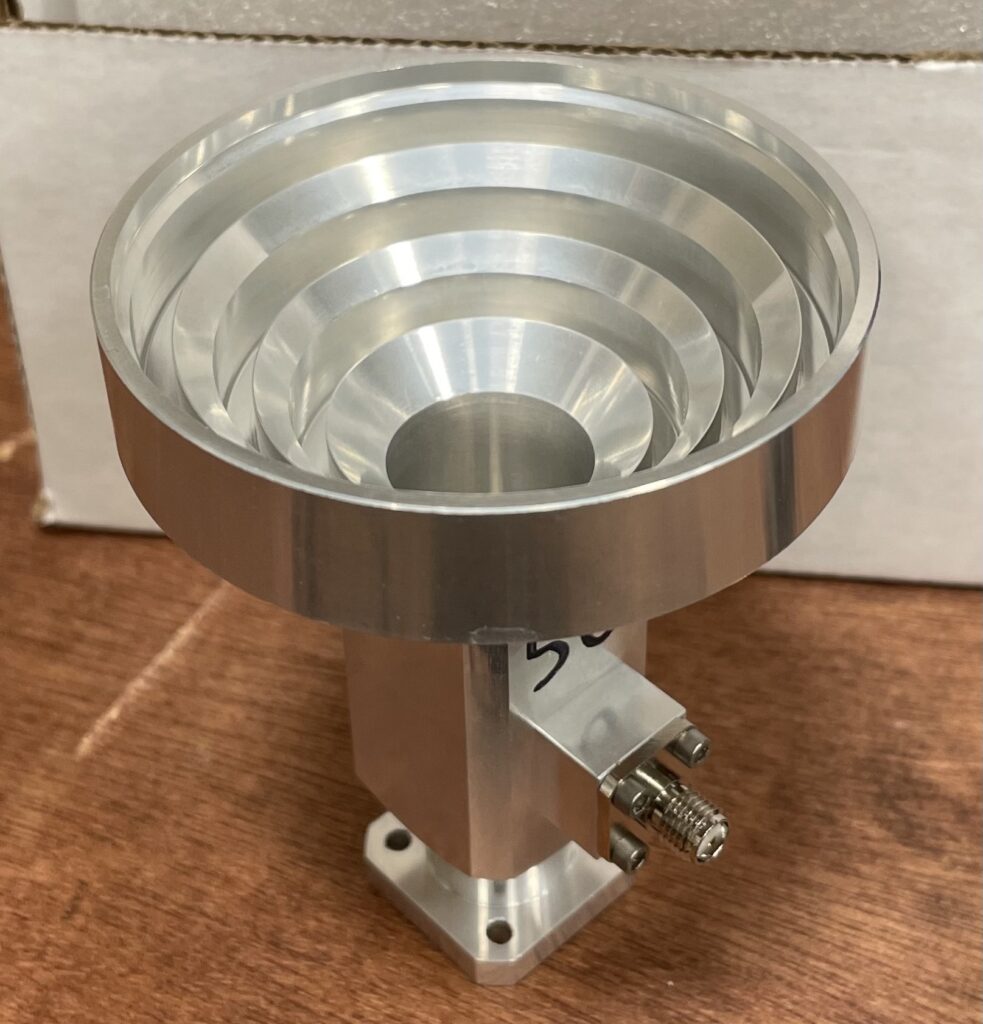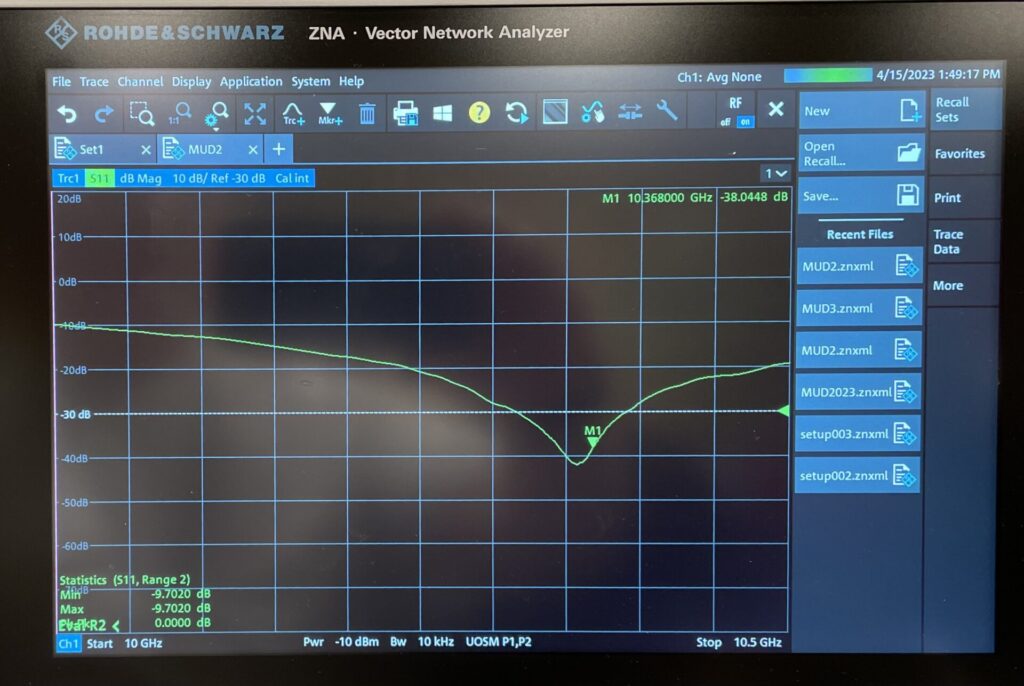--Update-- May 25, 2025 --Update--
We are currently out of stock on dual-band feeds. We expect to receive more in June, but only 25 remain from the run we produced in 2023. When the next batch arrives, we will perform final assembly and testing, and then we will prioritize international shipments. Our international friends have been extremely patient . . . and for that we are grateful as international shipments require a lot of paperwork.
If any feeds remain after we have completed international shipments, we will offer them for domestic buyers and will post an update here with an update. Thanks for your patience.
Introduction
Paul Wade, W1GHZ, produced a high-performance dual-band dish feed for 10 and 24 GHz, following the work of AD6FP (now K6MG) and AA6IW, designed to be used with offset dishes. W1GHZ made two previous production runs of these feeds, and they are in use around the world on 10 and 24 GHz with great results. The original design is available here.
These feeds typically show more than 30 dB return loss at 10.368 GHz and 20 dB return loss at 24.192 GHz. They offer typically at least 30 dB of isolation from 24 to 10 GHz. Isolation from 10 to 24 GHz is much higher because the 24 GHz feed is a waveguide beyond cutoff.
You can request an invoice for these feeds from this page. Payment is available only through PayPal.* Pricing is $250 per feed, plus shipping.

Project Start
In early 2022, K2UA began collecting a list of interested people for these feeds. The response was good, with more than 100 people responding in the first several months. We proceeded to partner with a ham-owned machine shop to do the production work.
How to Order
US domestic orders: Please note that no feeds are available for purchase at this time. See the latest news at the top of this page.
International orders: We will work through the existing interest list first. There is no need to send a new email unless your email address has changed. We will contact you in the order that we received your email.
RVHFG's Role
RVHFG volunteers perform final assembly, testing, and shipping. This is a purely volunteer effort; RVHFG does not make any profit on these feeds. Our role is to make the project possible so we can get these excellent feeds to you and you can put them on the air.

*If you do not have a PayPal account, email us at dualbandfeed@rvhfg.org. We can accept bank checks drawn on US banks, and will provide details on where to send them.
FAQ
Q: What kind of dish is this feed designed for?
A: Any offset dish that has a good enough surface for use at 10 and 24 GHz. The 18-inch DSS dishes for satellite TV work well. Other sizes of offset dishes from 12 inches to 1.2 meters have been used successfully with these feeds. Avoid mesh dishes like those common in the UK, because the surface is probably not good enough for good performance at 24 GHz.
Q: Where can I learn more about the design?
A: W1GHZ’s article on these feeds is located here: https://rvhfg.org/wpr/wp-content/uploads/2023/04/w1ghz-dual-band_feedhorn_2020.pdf
Q: How can I order?
A: We are currently out of stock and will post an update at the top of this page when there is an update.
Q: Does the Rochester VHF Group make a profit on these feeds?
A: No, the RVHFG does not make a profit on these feeds. This is a volunteer effort to help get more people on 10 and 24 GHz. All funds go to the machine shop that manufactures the feeds. Shipping costs are charged at their actual cost, including insurance. If you would like to make a donation to RVHFG to go toward scholarships or club projects, please send a donation in any amount via PayPal to dualbandfeed@rvhfg.org
Q: I live outside the US and I would like to combine shipping with my local friends. Can I do this?
A: Yes. Please send an email to dualbandfeed@rvhfg.org with “dual-band feed” in the subject line and explain your request, including your call sign and the calls of other operators in your group. Note: We will send only one invoice for a single shipment, so you will need to arrange for payment through one person on the receiving end.
Q: How can I mount this feed to my dish?
A: If it's available, use the stock feed horn mount that came with your offset dish. Attach it the mount to the feed between the conical section of the horn and the 10 GHz connector post. If you do not have the feed support that's made for your dish, see the article linked above and the online antenna book at https://w1ghz.org for guidance and placement techniques for offset dishes.
Q: What connections does the feed require?
A: For 10 GHz, the feed has a female SMA connector. For 24 GHz, use a WR42 (preferred) or WR28 waveguide transition or a section of waveguide that suits your equipment configuration. Keep connections for both bands as short as possible for best performance.
Q: How much isolation does the feed have between 10 and 24 GHz? Do I need extra isolation or switching to protect my radios?
A: The feed offers at least 30 dB isolation from 24 GHz to the 10 GHz port. From the 10 GHz to 24 GHz waveguide interface, the isolation is much higher because the 24 GHz section is a waveguide beyond cutoff at 10 GHz. You should not need additional isolation with typical power levels.
Q: How can I protect the open feed from the weather?
A: A Yo-Crunch yogurt container lid fits perfectly over the feed, with a bit of RTV or similar sealant around the outside edge. Another option is the cover removed from the satellite TV feed you probably received with the dish, or a piece of plexiglass and a bead of RTV on the outer edge (only) of the feed.
Q: What is the polarization of this feed?
A: This is a linearly polarized feed. Most stations use horizontal polarization on 10 and 24 GHz. When the 10 GHz feed connector is parallel to the ground ("sticking out to the side"), the antenna is horizontally polarized on both bands. Be sure to connect the 24 GHz waveguide transition in alignment with the opening in the feed.
Q: How can I optimize feed placement?
A: If you have enough space (100+ meters), you can place a weak signal source close to the ground, as far away as practical from your dish. The dish should be farther off the ground--2 meters is a good height. Peak the signal first in azimuth and elevation, and then adjust the feed position in small increments while watching the signal strength on your receiver. Optimizing for 10 GHz will provide very good performance on 24 GHz as the phase center of the feed is very close for both bands.